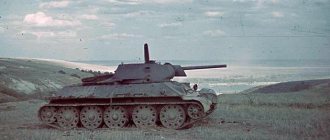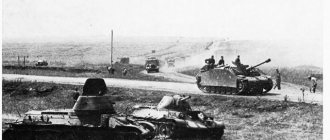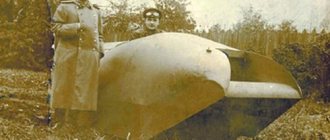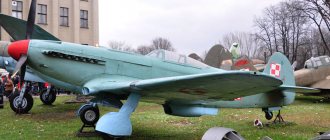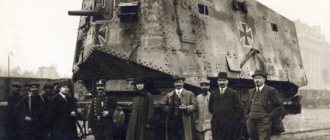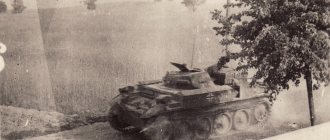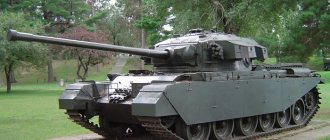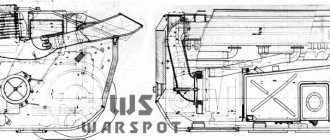Source
When comparing Soviet and German tanks of the war period, optics are often remembered. Mention of “Zeiss optics” in such disputes occurs constantly, and in most cases, debaters persistently confuse “warm with soft.”
The fact is that Soviet tanks were not inferior in terms of sights - many sights have survived to this day, and you can see them with your own eyes. German tanks won primarily in terms of observation devices. Their visibility was better than that of Soviet armored vehicles, which often became one of the factors for victory on the battlefield. At the same time, it is worth talking about the development of German tank optics during the war - the situation with it was very ambiguous.
Pre-war evolution and lessons from Spain
The Germans did not immediately develop a favorable situation with observation devices and sights. The appearance of those sights and viewing devices that appeared on German tanks after 1933 was preceded by an evolution that not every specialist remembers. Successful solutions usually emerge as a result of various trials and errors—the Germans were no exception in this regard.
It must be said that their work on surveillance devices began during the First World War. Even the first commander's cupola in its usual form appeared back in 1918 - it was equipped with the Sturmpanzerwagen Oberschlesien medium tank, which remained a project, and the LK-II, which was not a project at all, the final version of which is better known as Strv m/21.
In fact, the turret version of the tank, equipped with a machine gun, was created during the war, but they did not have time to complete the series, so the Swedes further used the developments. So, the brainchild of Joseph Volmer, which did not make it to the battlefields of the First World War, had excellent visibility for its time. There was a commander's cupola with viewing slots, viewing devices in the tower, some of which were covered with armored covers.
Against this background, his classmate Renault FT looked like a cramped, blind tin can. By the way, approximately the same opinion was expressed by Swedish tank crews who tested the Renault FT, purchased in a single copy. There was potentially an observation tower, but very little was visible from it. Naturally, the LK-II had the typical problems of all tanks of that period - first of all, the viewing slots were not protected, and therefore fire at them led to the defeat of the crew.
The LK-II had a commander's cupola and viewing slots, some of which were covered with lids. After the end of the First World War, all this seemed to be ignored
© warspot.ru
The anecdotal nature of the situation lies in the fact that the Germans practically did not take advantage of the experience of the First World War. From the point of view of the concept of sights and observation devices, those tanks that began to be designed in 1926 had nothing to do with the creations of Josef Vollmer. Both Krupp and Rheinmetall, who developed turrets for new tanks, did everything in their own way - sometimes contrary to common sense.
On the Armeewagen 20 medium tank, later renamed Großtraktor, the commander was completely removed from the turret and placed in the hull (to the right of the driver). He was given an observation tower, from where he, of course, saw something, but nothing more. The two-man turrets contained two periscopes (one of which was a sight), as well as a pistol port for the gunner. And it's all. The Germans do not tactfully write about the visibility of this tank, but it was very low.
The turret of the Leichttraktor light tank turned out to be even stranger. It was developed by Rheinmetall; outwardly it looked more rational: the instruments included the same combination of a periscope sight and a viewing periscope, and in the side hatches there were viewing slots covered with glass blocks. At the same time, the tower was by no means double. In fact, initially its crew consisted of three people - a gunner on the left, a loader on the right and a commander in the back. The periscope observation device was intended just for him. But the very first tests at TEKO showed the absurdity of such an idea. It turned out to be very crowded inside the tower, so the commander was removed out of harm's way, and the tower became a two-seater one.
A typical solution on the first German tanks of the interwar period was the use of periscope sights
© warspot.ru
As a result, the visibility of the first German pre-war tanks turned out to be very poor - at least it was not superior to their foreign counterparts.
However, some countries have adopted the idea of a periscope sight and observation periscope.
Firstly, it was “cut” by Soviet tank builders - this is how the PT-1 tank periscope panoramic sight and the PTK commander’s periscope device were born.
Secondly, the Leichttraktor turret, in a slightly modified form, was transferred to the Swedish Strv m/31 tank. And subsequent Swedish tanks had a similar design - especially with regard to sights and observation devices.
At the same time, the commander's cupola appeared on the Strv m/38, which had a slightly different turret. Thirdly, through the Swedes (namely Bofors) this sight principle came to the Poles, so the Leichttraktor and 7TP are in a sense relatives (at least their gun mounts and sights have common roots).
German pre-war ideas on tank optics were picked up in Sweden. On the Strv m/31 and a number of other Swedish tanks, which were created, in fact, with German participation, you can see the same developments
© warspot.ru
In July 1932, development began on a new medium tank, which was initially called the M. Tr. The development was entrusted to Rheinmetall as the author of the most successful version of the Großtraktor. However, it was a completely different tank with extremely interesting features. Apparently, the Germans looked very carefully at the English Medium Tank A6, since some ideas were clearly taken from there - in particular, machine gun turrets, and, like the British, there were two machine guns each. And the Rheinmetall turret was clearly made with an eye on the main A6 turret, the main innovation of which was the commander’s cupola, which was moved back, and so that the tower had a protrusion under it.
Subsequent development of M. Tr. led to the creation of the Nb tank. Fz., which is known to us as “Rheinmetall” (after the name of the development company). The vehicle turned out to be a dead end, but a number of solutions were implemented on it, which later became fundamental for German medium and heavy tanks. This also applied to surveillance devices.
The commander received a cupola, located in the rear of the tower, behind the gun mount. In addition, from machine gun turrets for Nb. Fz. The turret for the La light tank was partly evolved. S., better known as Pz.Kpfw.I. This turret is interesting because just after it, the “horseshoe” became the favorite “head” shape of German tank builders.
Original project Nb. Fz. This vehicle was a milestone for German tank building; many solutions for surveillance devices migrated to other models from it.
© warspot.ru
In the case of the Pz. Kpfw. I had some other features associated with tank optics. Firstly, this tank was equipped with a 2.5x telescopic sight T. Zf.2.
The Germans again decided that they were not like everyone else, so it was not just a “pipe”, but a very interesting sight in design, which had a kind of “knee”. There was a kind of adapter, thanks to which the eyepiece of the sight was located above the driver’s head. This made aiming safer and also allowed for more convenient sight placement. Secondly, the Pz turret. Kpfw. I, developed by Daimler-Benz, was the first to have inspection hatches in the movable armor of the mask.
The decision was quite controversial, since there was a risk of getting a bullet or shrapnel in the forehead, but it was then transferred to the Pz turret. Kpfw. II, as well as Pz. Kpfw. III. On the tower Pz. Kpfw. IV, which was developed by Krupp, these hatches were also there, but they were moved to the front part of the turret. Finally, this tower had four inspection hatches on the sides and stern.
Starting from Pz. Kpfw. I, the typical shape of the German tower became a “horseshoe”. The development of German viewing devices and sights began with the same tank.
© warspot.ru
Thanks to this solution, visibility improved, but at the same time, some decisions on hatches were controversial. To begin with, only two of the four hatches had viewing slits, and the rear pair had them. That is, in order to see something, these hatches had to be opened slightly (hello, stray bullet!). In addition, those hatches that had viewing slots were equipped with glass blocks with tempered glass, similar to those made by Sekurit - the idea was not bad, but only in theory. Similar viewing devices were placed in the turret box.
On Pz. Kpfw. II, a “combat driving” device for the driver appeared, one of the calling cards of German tanks
© warspot.ru
Further development of viewing devices was carried out on the Pz. Kpfw. II. There, the driver received a different design for the viewing device, and was paired with a binocular “combat driving” device. It was a structure that moved along “rails” on the roof of the control compartment. In the combat position, the inspection hatch, which did not have a gap, was closed, the combat driving device was placed in the working position, and the driver observed the situation, clinging to the eyepieces.
This system was considered more successful than the Pz driver’s viewing devices. Kpfw. I, they were used on the prototype BW, as well as Pz. Kpfw. III Ausf. A.
As for the new German medium tanks, they used a very successful sight design. T. ZF.5 was a so-called “breakable” sight, that is, it had a block of prisms, thanks to which its front part was movable. Thanks to this design, the sight did not need to be placed strictly along the line of the turret - it was placed in a way that was convenient for the gunner. This system significantly improved the gunner’s comfort, and, therefore, aiming.
Improved viewing devices that appeared as a result of summarizing the experience of the war in Spain
© warspot.ru
Then the first combat use of German tanks happened in Spain. Among German military aid to the Francoists were Pz. Kpfw. I Ausf. A, which were used by the Spanish crews and the Condor Legion. During the battles, it quickly became clear that German machine-gun tanks could do little with the Soviet T-26s.
One German tank was captured and sent to the USSR, where it was studied in detail. At the same time, NIBT Polygon had no complaints about the optics, including viewing devices. But the Germans themselves had a slightly different opinion. Lieutenant Colonel Wilhelm von Thoma, who led a group of German instructors and mechanics, prepared a very tough report at the end of November 1936, in which he “went through” the viewing devices.
It turned out that for small-caliber bullets, viewing slits are a good target, and glass blocks are quite pierced by bullets and fragments. It is worth noting that Soviet glass blocks were more reliable, especially in terms of protection, although German viewing devices provided greater visibility. As a result, on Pz. Kpfw. II Ausf. A improved viewing devices were introduced. Now the glass blocks had a thickness of 50 mm, and the shape of the inspection hatches changed somewhat. The design of the driver's inspection hatch has changed significantly; it now has a V-shape in profile; an inspection slot has also been made in it. These hatches were also introduced on the Pz. Kpfw. IV Ausf. A and Pz. Kpfw. III Ausf. B.D.
These were the observation devices of the driver and commander in German medium tanks of 1939. At that time they were one of the best, however, using a system with glass blocks was not a good idea
© warspot.ru
The identified problem with the reliability of viewing devices had to be corrected on the commander’s turrets. It quickly became clear that the existing turret design, which did not have protection for the viewing slots, was vulnerable to rifle and machine-gun fire. At the same time, Pz. Kpfw. IV Ausf. A and Pz. Kpfw. III Ausf. A and B were forced into production with the old turret design. Starting with Pz.Kpfw.III Ausf. C and Pz. Kpfw. IV Ausf. B, they introduced a new turret with a special “visor” that covered the viewing slots. Such a turret lived on these machines for quite a long time.
In addition, on Pz. Kpfw. IV Ausf. B introduced a new driver's viewing device, Fahrersehklappe 30. It had two “eyelashes” that moved up and down and provided more reliable protection. This device was introduced on Pz. Kpw. III Ausf. E and installed until mid-1940. Later he appeared on Pz. Kpfw. II Ausf. F. It was already designed for fire from large-caliber machine guns. There are also new Sehklappe 30 inspection hatches, more massive and with thicker glass blocks.
Thus, by the beginning of World War II, the Germans had come a long way in the development of tank optics, which, of course, had positive consequences for them. From the point of view of viewing devices, they were the undisputed leaders at that time. At the same time, there were some shortcomings that began to appear later.
American tanks
American tank production can be called perhaps the most painless, because they were built based on the experience of others. Since 1942, production of the Sherman, extremely successful for its time, began, which became the main tank not only for the American army, but also for the Allied troops. However, since the Americans were guided by other people's decisions in the production of tanks, mistakes also occurred - the long production and use of light tanks, the release of the new Chaffee model in 1944, while other countries preferred more reliable medium and heavy tanks, which could not have been better confirms.
The merits of tank crews and engineers of the Second World War are indisputable. Both the construction of tanks and their management is an entire art, honed by trial and error. Without tanks, victory would hardly have been possible, and the incredible qualitative leap that has been made in the field of engineering in just five years truly deserves respect.
From leaders to laggards
The Polish campaign revealed some shortcomings associated with the observation devices of German tanks. From the point of view of medium tanks, the situation turned out to be more or less normal - at least, there were no special problems, although indirect signs did reveal something. The Fahrersehklappe 30 did not provide complete protection against shrapnel and bullets of calibers higher than rifle caliber.
The system with “eyelashes” going up and down had too large an area, and there was a chance of jamming it. Therefore, in the spring of 1940, a new version of the Fahrersehklappe 30 appeared. Now the viewing device was more massive, and instead of two “cilia” there was a kind of visor that more reliably covered the viewing slot. There was also a new commander’s cupola, in which not the entire “tackle” rose and fell, but only small fragments.
As a result of the Polish campaign, the viewing devices of medium tanks were improved. Subsequently, the strengthening occurred only due to thicker armor of the devices.
© warspot.ru
The situation with the Pz. turned out to be more complicated. Kpfw. II, at that time the most popular German tank of the first line. The idea with a bunch of inspection hatches may have worked well in peacetime, but during the war, German tank crews severely criticized the light tank for poor visibility from the commander's seat. Meanwhile, in September 1939, the Germans became acquainted with the most progressive invention of the Polish tank industry. We are talking about the periscope viewing device of Rudolf Gundlach, better known as MK-IV.
Periscope viewing devices existed before that - for example, in the commander's turrets of Czechoslovak tanks there were periscopes, but not of the simplest design. The advantage of Gundlyakh’s idea was that it used a prism system, which was simpler and more reliable than “mirrors”.
Additionally, if the top of the periscope failed, it could be removed from the inside, the top replaced, and it would work again. Also, the MK-IV could be rotated in different directions; it had a small degree of freedom in the vertical plane. The result was an excellent viewing device, variations of which are still used in armored vehicles today.
Commander's cupola Pz. Kpfw. II was the first case of the use of prismatic periscope observation devices on German production tanks
© warspot.ru
The Germans also appreciated Gundlyakh’s brainchild, but in their own way. Actually, the genius of the very idea of a device with circular rotation clearly passed them by. But the Germans appreciated the design of the periscope itself and copied it in their own way. In October 1940, work began on installing previously released Pz. Kpfw. II Ausf. cC commander's cupola, equipped with eight periscopes, repeating the design of the MK-IV. The result was a very successful design, perhaps the best commander's cupola at that time. It provided excellent all-round visibility; the periscopes themselves were covered on top with an armor plate. Most importantly, the turret turned out to be very low, and the commander’s head did not protrude beyond the dimensions of the turret - from a safety point of view, this was a very correct decision.
The Germans did not look for difficult ways and copied the Gundlyach periscope. But only partially
© warspot.ru
At that moment, Gundlyach periscopes were already used on British tanks, “DSLRs” of their own design appeared on Soviet tanks (primarily KV, but so far Soviet devices were inferior in design and placement). There were a lot of mirrors, but they were positioned irrationally, so the visibility was very poor. That's why Pz. Kpfw. III Ausf. G, which was purchased in 1940, made such an impression. Despite the fact that this car used relatively outdated glass block instruments, they provided greater visibility. For this reason, for example, on the KV-3 it was planned to make turret side inspection hatches like the Pz. Kpfw. III, as well as the commander's cupola. Moreover, unlike the Germans, Soviet designers initially intended to install periscopes in the turret, not glass blocks.
An example of German conservatism. On Pz. Kpfw. Tiger (P) there were no prismatic periscopic devices in principle
© warspot.ru
Familiarity with prismatic periscope observation devices usually meant that they gradually switched to them. But this was not always the case, and sometimes, more surprisingly, periscope devices were partially abandoned. This happened with German heavy tanks. The VK 30.01 (H) was supposed to use a whole battery of turret-mounted periscope devices. The gunner had one periscope, the loader had two, and the commander had a Pz-type turret. Kpfw. II. True, a logical question arises as to why the periscopes of the gunner and loader were stationary, because such placement significantly limited visibility from their positions. The situation with the VK 36.01 turret was very similar, but there the gunner lost his periscope. By the way, both towers had side inspection hatches.
But the VK 30.01 (P) turret, which later evolved into the “head” for the Pz. Kpfw. Tiger Ausf. E, looked like a clear step back - not a single periscope and “retrograde” slit viewing devices with glass blocks. To say the least, a strange decision for a tank that was supposed to have reliable armor protection. It also seemed obvious that the infantry would clearly fire at the viewing slits. No less strange was the driver’s position on the viewing devices. If the VK 30.01 (H) had a viewing device similar to the Fahrersehklappe 50 (essentially, the Fahrersehklappe 30, but for an armor plate 50 mm thick), then the VK 30.01 (P) and VK 36.01 received a less progressive design. The device was more massive, but for some reason they returned to a system with a raised “eyelash”, which was more vulnerable to enemy fire.
Viewing devices for the Pz. fighting compartment. Kpfw. Tiger Ausf. E
© warspot.ru
In this sense, the situation with Pz viewing devices looks strange. Kpfw. Tiger Ausf. E. Its turret, which, as already mentioned, was the result of the evolution of the VK 30.01 (P) turret, and also an excellent demonstration of the combination of the progressive binocular telescopic sight T. ZF.9b and viewing devices that are frankly behind world trends. At first, there were no periscopes in the turret at all, and the gunner and loader had only two viewing slits in the sides. There were periscopes in the hull - they stood in the hatch doors of the driver and radio operator. But someone at the top clearly believed that rotating periscope devices were not according to the Ordnung, so the periscopes were rigidly attached to the hatch doors. Very little was visible from them.
Naturally, surveillance devices were among the priority targets for the infantry
© warspot.ru
The turret itself turned out to be quite high, which made it a priority target for the enemy (for example, it was such in the Soviet instructions for combating the “Tiger”). What did they think about the commander's cupola of the Pz. Kpfw. Tiger Ausf. E German tank crews themselves, can be clearly seen from the memoirs of tank ace Otto Carius:
“The commander’s cupola was completely demolished from my Tiger. The fragments hit my temple and face. The wounds, of course, bled heavily, but nothing more. Kramer always judged me for smoking, but if I had not bent down to light a cigarette, my head would have remained in the turret at the critical moment. It hardly needs saying that I would be blown away in the most literal sense of the word. And I wouldn't be the first person this happened to. The reason should be sought in a design flaw. On the first Tigers, the commander's cupola was still welded on. It protruded high and had straight viewing slits. The hatch cover stuck vertically upward when it was open. Thus, it should be clear to everyone that the tank is vulnerable from above. It was enough for a shell with a high explosive to hit the hatch, and the entire charge would fall on the commander’s head. If the commander wanted to close the hatch, he had to lean over the side of the vehicle and climb out up to his hips to release the safety bolt that held the lid in place.”
Another point that can be found in the memoirs of Carius, and many other memoirs of German tank crews, is considered by many to be an advantage. This is because German commanders often acted in battle while leaning out of hatches. Thus, according to Carius, an advantage over Soviet tanks was ensured. But if you think about this fact, you remember the saying “the feat of some is always the crime of others.” This meant one simple truth - good visibility of German tanks was still insufficient. In a combat situation, the head sticking out of the hatch was a priority target. This was recognized by Carius himself, who acquired a stereo tube.
A similar situation occurred with the Panther devices.
© warspot.ru
The new German medium tank Pz. initially had exactly the same shortcomings. Kpfw. Panther. It had a very similar commander's cupola with slits covered with glass blocks. The gunner and loader had no viewing slits at all, let alone periscopes. In combination with the sophisticated binocular telescopic sight of the T. ZF.12, it looked very strange. The situation with surveillance devices in the control department was a little better. Both the driver and the radio operator had periscopic viewing devices. In addition, the driver had an inspection hatch in the upper frontal plate of the hull. In fact, we used this hatch more when driving because it gave us more visibility. At the same time, none of the periscope observation devices were made rotating, which partially negated measures to improve visibility. At the same time, it is clearly visible that the German designers gradually deprived the crews of visibility from the flanks.
Later, new commander's turrets were installed on the Tiger and Panther, but they were still high and very vulnerable
© warspot.ru
This is especially clearly seen in the evolution (or, more precisely, degradation) of the viewing devices of German medium tanks in 1942-1944. The changes began in 1942 and were directly related to the appearance of a large number of anti-tank rifles in the Red Army. If anyone thinks that in the instructions for fighting enemy tanks they wrote “shoot at viewing slits and hatches” for show, then they are deeply mistaken. Blinding an enemy tank was an important task for the infantry, and they did it constantly. As a result, the inspection hatches on the sides of the turrets first disappeared from German medium tanks. They already had no viewing slots, so they were partly a useless structure, and the side was weakened quite significantly. Further on Pz. Kpfw IV Ausf. G removed the loader's inspection hatch in the forehead of the turret. The next victims were the inspection hatches in the sides of the turret box. As a result, the only viewing devices left were the commander's cupola, the gunner's sight, his viewing hatch in front (removed on the Pz. Kpfw. IV Ausf. J) and the driver's viewing device. By the way, by the time the Pz. Kpfw. IV Ausf. H the “combat driving” device was removed.
The situation with viewing devices on Pz. Kpfw. IV by 1944. Apart from the commander's cupola, there were no other devices for viewing on the sides, and the side hatches were usually covered with screens
© warspot.ru
In this regard, the Germans were not at all alone. Shooting at inspection hatches was one of the favorite pastimes of the infantry, so they disappeared on American tanks. But there was one significant difference. While removing some observation devices, designers in other countries worked on introducing other, periscope observation devices, which either completely copied the MK-IV or had a similar principle. In 1943, the requirement to introduce the MK-IV was sent from the GBTU KA to Soviet tank builders - not without difficulties, but this observation device also appeared in our country, like its analogues. The Germans’ surveillance devices were confiscated without replacing them with others, despite the fact that there was a potential opportunity to install a periscope on the Pz. Kpfw. IV was quite there. This is the paradox of the situation with German tanks - they began to suffer from the same shortcomings as Soviet tanks in 1941-1942.
At the end of the war, German tanks began to often be hit by fire from the flanks - exactly the same thing happened as with Soviet tanks in 1941-1942
© warspot.ru
Of course, some work on bugs was carried out. Pz. Kpfw. Tiger Ausf. E received a loader's periscope during production, as well as a new commander's cupola with prismatic viewing devices. A similar story happened with Pz. Kpfw. Panther, and in 1944 they also removed the driver’s inspection hatch, which was vulnerable to enemy fire. But these were nothing more than half measures. And the Pz. that appeared in 1944. Kpfw. Tiger Ausf. B suffered from the same problems with visibility down the flanks. What exactly prevented German designers from installing rotating periscopic viewing devices on tanks is a mystery. What prevented them from making Ferdinand-type viewing devices for the driver (and there were as many as three periscopes, this is a record for the Germans) also remains unclear. It’s hard to believe that the Germans couldn’t do this - the same Jagdpanzer IV and Jagdpanther tank destroyers had rotating periscope observation devices.
The most interesting thing is that the Germans could make periscope viewing devices with the ability to rotate, but for some reason they didn’t want to
© warspot.ru
Of course, the general production situation, which became more complicated since the beginning of 1944, gradually affected optics. The same German “menagerie” was forced to switch to monocular telescopic sights. At the same time, it is easy to notice that the crisis with surveillance devices occurred at a time when the situation was not yet so difficult. Of course, in other countries there were plenty of problems, however, the overall picture is obvious - while in some tank-building powers the visibility situation was improving, in Germany it was definitely getting worse.
Design concept
The concept of the T-34 tank is not a sudden inspiration of the designer. This is the result of enormous focused work of the complex system of Soviet tank building, which was actively created over more than 10 years on the initiative and under the leadership of the Communist Party and the government of the USSR in preparation for the upcoming war.
The design of the T-34 was conceptually the most advanced for its time, which is recognized by almost all domestic and foreign experts in military equipment.
The suspension, optimal angles of inclination of the surfaces of the hull and turret, the general layout of systems and assemblies, an economical diesel engine and the main weapons themselves were chosen extremely well, and their combination gave a powerful synergistic effect.
The ideas underlying the T-34 concept determined the direction of world tank construction for a long time.
Pre-war tanks produced by plant No. 183. From left to right: A-8 (BT-7M), A-20, T-34 mod. 1940 with L-11 cannon, T-34 mod. 1941 with an F-34 cannon Photo: ru.wikipedia.org
